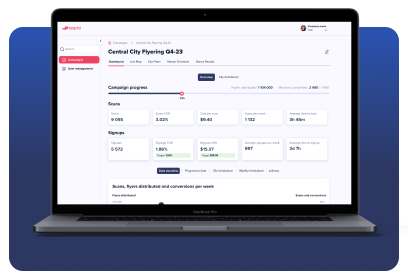Offline marketing campaigns can be a great way to reach potential and existing customers. But how do you know if they’re successful? Measuring your offline marketing campaigns’ return on investment (ROI) is a great way to determine their success.
Here are some essential steps to consider to measure your offline marketing campaigns more effectively
Define goals for offline marketing campaigns
Define clear goals for your offline marketing campaigns and establish benchmarks to measure progress towards these goals over time.
Examples of your campaign goals:
- Attract foot traffic to your physical store, which can help increase sales and boost overall revenue,
- Increase brand awareness and visibility
- Drive new leads and customers, or
- Build stronger relationships with existing customers
Define Campaign Metrics
Key metrics to track your offline marketing campaigns can include store visits, phone calls, website visits, engagement, QR code scans, coupon code usage, the number of leads generated, or sales conversions.
It may be helpful to set up tracking systems or analytics tools to provide real-time data on metrics like traffic patterns, conversion rates, lead quality, and other key campaign performance indicators.
Define KPIs to help measure your offline marketing campaigns

A critical step in measuring the effectiveness of your offline marketing campaigns is to identify and define KPIs. Key Performance Indicators (KPIs) are a set of quantifiable metrics that can help you assess the impact and ROI of your marketing efforts.
Some common KPIs for offline marketing campaigns include cost-per-lead, cost per conversion or sale, lead-to-sale conversion ratio, and the overall return on investment (ROI).
Ways to Measure Offline marketing success
Create customized URLs for offline campaigns
Creating customized URLs for your offline campaigns helps track each campaign’s performance in real-time and lets you know how users interact with these pages.
By taking advantage of the unique tracking capabilities, you gain better insights into the performance of your offline marketing efforts and make changes to optimize your campaigns.
You can then track traffic, conversions, and the overall effectiveness of your offline campaigns by analyzing data of users who visit these URLs using Google Analytics.

Create custom landing pages
A custom landing page lets you continue the conversation that started offline by providing more detailed information about the promotion or product while allowing you to track the number of users who visited these pages.
Create a custom landing page for each campaign explicitly designed to capture the attention of potential customers. You can easily track and measure the performance of your offline campaigns by analyzing these landing pages using google analytics.
Analyze the data over time to identify any areas for improvement. You can use these insights to optimize the landing pages for optimal results and get the most out of your offline marketing campaigns.
Include QR codes

QR codes are short, machine-readable codes that can be scanned with a smartphone or mobile device to link you to relevant content or websites. You can easily track which customers have interacted with your brand by including a unique QR code with your print advertisements, flyers, business cards, or other promotional materials.
Use QR codes in your offline marketing campaigns to track the effectiveness of your offline marketing efforts and see how many people are engaging with your brand. You can also use these codes to collect data about which marketing strategies and tactics resonate most with your target audience and allows you to optimize your future campaigns for even greater success.
Use promo codes
Track your offline marketing campaigns effectively by assigning specific promo codes for each campaign. Promo codes allow you to identify campaigns that drive traffic and conversions and those that don’t. You can then use this information to adjust or optimize your marketing efforts.
Once you have assigned promo codes, you can use tracking software to monitor the performance of your campaigns in real time.
Use promo codes in conjunction with tracking software to evaluate your offline marketing efforts and understand their results.
Measure brand awareness through Google Search Console

Although using Google Search Console doesn’t give you results from specific campaigns, it can help you measure brand awareness over time. As you branch out and market your brand offline and online, it’s a good idea to track brand awareness.
Open the Search Console, navigate to the main dashboard and select ‘performance’ from the left-hand menu. This section gives you a list of search queries customers have typed into the search engine to find you. Sift through for the branded search queries — how many clicks and impressions have these searches received?
You can set a custom period to analyze branded search queries over time, and as your campaigns gather momentum, you should see an increase in branded search queries (the graph comes in pretty handy, too).

Track call volume through custom phone numbers
You’ve seen TV ads prompting the viewer to call a number to place an order or enquire, right? These numbers are usually attached only to that advert campaign, making it easy for companies to track interested customers through call volume.
If you have the budget and resources, promoting one number per campaign or channel means customers don’t have to jump through hoops going through a switchboard to find the correct department. Customers don’t have to explain why they’ve called, as the phone number assigned to each marketing campaign is unique.
Using custom phone numbers makes enquiring and tracking customer conversions straightforward.
Conclusion
By understanding how to measure the success of your offline marketing campaign, you can optimize your efforts for maximum ROI. Use these tips to fine-tune your next offline marketing campaign and ensure success.






